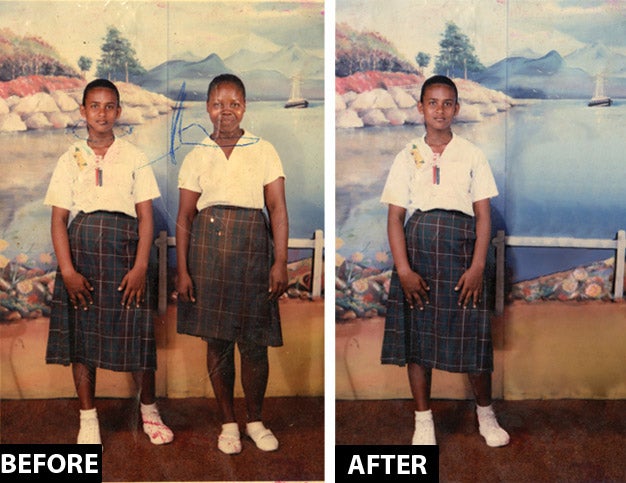Software Workshop: How To Remove a Person From a Photo
Use Adobe Photoshop's cloning and healing tools to make a figure disappear


As a 13-year-old growing up in Point Fortin, Trinidad, Jennifer Marshall and her best friend saved up to have their portrait taken at a local studio. Now living in New York City, Marshall still had a print, but it was somewhat the worse for wear. And it was the only picture she had of herself at that age. When she asked if I could restore it and convert it to a solo portrait, I was excited for the challenge.
A project like this takes time, patience, and imagination. Here’s how to work on this one; each picture you do will involve a similar process. One thing is on your side, though. When people look at pictures, they usually assume the pictures are true. So don’t worry about making it perfect—your viewers will be too busy enjoying the photo to wonder whether or not it’s fake.
Step 1

Start by making a copy of your background layer; this way you’ll have an accessible copy of your original image if you need it. When removing someone from a picture, use what you can from the original and invent as little as possible. Here, we can use the background on the right to cover the figure we’re removing. Type L to get the Lasso tool, then make a selection around the extra background on the right.
Step 2

Then type Ctrl (Command on a Mac) + J. This keyboard shortcut copies all the selected information and pastes it into its own, new, layer. Now type V to get the Move tool, and shift your copied image information to the left to cover as much of the figure as possible. Then use the Crop tool to trim out the background that you copied and moved, and to get a clear view of your progress.
Step 3

Continue to use the method from Step 2 to cover the figure: Select chunks of your image, type Ctrl+ J to copy them to their own layer, and shift them to cover more and more parts of the figure. (Sure, you could use the Clone Stamp for this process, but for bigger areas this method can be more precise and much faster.) When you need to, type Ctrl + E to merge your copied areas to the layer below. This will keep your cover-up sections together on a single layer. After a few minutes you’ll have a draft of your final image that will need quite a bit of finessing using the cloning tools.
Step 4

Create a new layer and type J to get the Healing Brush tool. Make sure Aligned Sample: Current and Below is selected in the Options Bar, and use the Healing Brush to get rid of any jagged edges. Sample smooth sections of the photo and paint over the seams to blend them together. This is a quick way to clean up areas, like the water, that are low on detail. While you’re working with the Healing Brush, use the tool to fix any blemished areas, such as spots or pen marks.
Step 5

Once you get the smooth areas done, you can tackle the areas where you’ll need to invent new detail. Here, the Clone Stamp (and all of its options) is your best friend. Type S to get the tool, then go to Window > Clone Source to see all of its awesome controls (note: you can access these for the Healing Brush, too). Click the Flip Horizontal or Flip Vertical icons to grab flowers from the left side of the image and clone them in reverse on the right. You can also rotate the clone source as much as you like. Since pattern repetition is a clue that the image is retouched, do your best to transform the data you grab from other areas in the picture.
Final Step

As long as the image’s color cast isn’t major, you can tackle it when you finish retouching. Make a Curves Adjustment Layer and maneuver each color channel until the picture looks more neutral. In this case, total neutralization removes too much of the picture’s original vintage character, so dial down the Adjustment Layer’s opacity to around 50 percent.